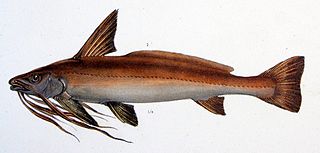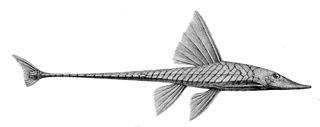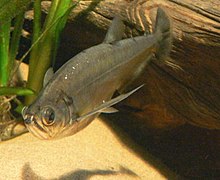
Characidae, the characids or characins is a family of freshwater subtropical and tropical fish, belonging to the order Characiformes. The name "characins" is the historical one, but scientists today tend to prefer "characids" to reflect their status as a by and large monophyletic group at family rank. To arrive there, this family has undergone much systematic and taxonomic change. Among those fishes that remain in the Characidae for the time being are the tetras, comprising the very similar genera Hemigrammus and Hyphessobrycon, as well as a few related forms such as the cave and neon tetras. Fish of this family are important as food and also include popular aquarium fish species.

The payara, Hydrolycus scomberoides, is a species of dogtooth tetra. This predatory fish is found in the Amazon Basin in tropical South America. It was the first of four species to be described in the genus Hydrolycus.

Cynodontidae, also known as dogtooth characins or vampire tetras, are a family of predatory, characiform freshwater fishes from South America. This group is not very diverse, and includes only five genera and 14 species. Most of what is known about this family is from the members of the subfamily Cynodontinae, which includes the largest species of this family, up to 117 cm (3.84 ft). The members of subfamily Roestinae only reach up to 20 cm (7.9 in). and are less known.

Acanthicus is a genus of large, South American suckermouth armored catfishes native to the Amazon and Orinoco basins, and possibly in Guyana. The name Acanthicus is derived from the Greek, akanthikos meaning thorny, spiny. Fish of this genus are known as lyre-tail plecos. These species are found in large rivers, primarily in areas with a rocky bottom and a moderate or strong current.

The firewood catfish a species of South American pimelodid catfish, is the sole member of the genus Sorubimichthys. Known by locals along the Amazon Basin as peixe-lenha, the firewood catfish is so called because it is of little eating value and is often dried and used for firewood.

Pinirampus pirinampu is a species of catfish of the family Pimelodidae. P. pirinampu is also known as the flatwhiskered catfish.
Hypophthalmus is a genus of long-whiskered catfishes native to freshwater in tropical and subtropical South America.

Sturisoma is a genus of armored catfishes native to Central and South America.

Pristobrycon is a genus of piranhas from the Orinoco and Amazon Basins, as well as rivers in the Guianas.

Myloplus schomburgkii, also known as the Disk tetra, Disk pacu, Black-ear pacu, Black-band myleus or Black-barred myleus is a species of serrasalmid with a black bar on its side. This species is found in the middle and lower Amazon River basin, Nanay River, upper Orinoco River basin in Brazil, Peru, Venezuela and possibly in Suriname.

The biara is a South American piscivorous fish in the dogtooth characin family. It belongs to the monotypic genus Rhaphiodon, although some minor differences in morphometrics and colour are known from across its large range. It is found in the Amazon, Orinoco, and Río de la Plata Basins, as well as rivers of the Guianas. It occurs in a wide range of freshwater habitats such as main river channels, flooded forests, lakes and reservoirs. Some populations are migratory.

Prochilodus is a genus of freshwater fish from the family Prochilodontidae. This family include two other genera, Ichthyoelephas and Semaprochilodus, which have been included in Prochilodus instead. The greatest species richness of Prochilodus is in river basins in eastern, southeastern and southern Brazil, but there are also species in the river basins of the Amazon, Guianas, Colombia, Venezuela, Paraguay and northeastern Argentina. The largest species in the genus reach about 80 centimetres (2.6 ft) in length, but most species barely reach half that size.

Mylossoma is a genus of serrasalmids from tropical and subtropical South America, including the basins of the Amazon, Orinoco, Lake Maracaibo and Paraguay-Paraná. These common fish are found both in main river sections and floodplains. They support important fisheries and based on a review by IBAMA, they are the seventh most caught fish by weight in the Brazilian Amazon. They primarily feed on plant material such as seeds and fruits, and in their ecology they generally resemble the larger tambaqui. Mylossoma reach up to 28.5 cm (11.2 in) in length and 1 kg (2.2 lb) in weight.

Boulengerella is a genus of pike-characins from tropical South America, found in the Amazon Basin, Orinoco, and rivers of the Guiana Shield. Boulengerella was named after the Belgian ichthyologist George Albert Boulenger. The currently described species are:

Cynodon is a genus of dogtooth characins from tropical South America, including the Amazon and Orinoco basins, and rivers in the Guianas. These predatory fish reach up to 32.2 cm (1.06 ft) in standard length. They are mainly piscivorous, but will also take insects.

Hydrolycus is a genus of large dogtooth characins from tropical South America, where found in the Amazon and Orinoco basins, as well as rivers of the Guianas. The genus includes the largest dogtooth characins, reaching up to 1.17 m (3.8 ft) in length. They have long, pointed teeth used for spearing their prey, generally smaller fish. In a study of the stomachs of 45 individuals, most were empty, but among the remaining the prey fish were 15–50% of the length Hydrolycus itself.

Hydrolycus armatus or black tailed payara is a species of dogtooth characin found in freshwater of tropical South America. It is sometimes known as the payara, a name it shares with the related H. scomberoides.
Cynodon septenarius is one of three species of dogtooth characins in the genus Cynodon. It is the most recently described member of its genus. This fish is found in tropical fresh waters of South America, including the Amazon and Orinoco basins, and rivers in Guyana.

Hydrolycus tatauaia, or fire tail payara, is a species of dogtooth characin found in the Amazon, Orinoco and Essequibo basins in tropical South America. Adults mainly occur in deep and/or fast-flowing rivers. It is migratory, moving upstream to breed in November–April.
Hypophthalmus oremaculatus, is a species of demersal catfish of the family Pimelodidae that is native to Paraná River basin of Argentina and Brazil.
















